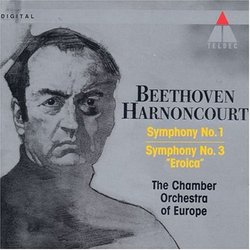Magnificen Beethoven by Harnoncourt. HARNONCOURT???!!??
R. C. Walker | Encinitas CA, United States | 09/11/2003
(5 out of 5 stars)
"I believe it's fair to say that Beethoven's 3rd Symphony was the "Rite of Spring" of the 19th Century. Although the Romantic revolution was in the air, even in Mozart and (to a lesser extent) Haydn, this is the piece that shattered the barriers, the conventions, and the eardrums of the Viennese music world. And this recording will show you why.Nikolaus Harnoncourt is one of the great icons of the "period instrument" school of performance. There is nothing like an orchestra of instruments from the late 1700s and early 1800s to produce a remarkable clarity of orchestral tissue. However, in these performances - save for the use of natural horns - Harnoncourt employs modern instruments. Even so, he achieves that same clarity. His later recordings in general may come as a surprise to those who know his early reputation for technical, bloodless performances - and years ago that's apparently what they were. I've heard practically none of them, so I can't vouch for that -- in all fairness, if so, this probably resulted mostly from his concept of performance practices in the Baroque era. By the time he hit the early Romantic repertoire, a miracle happened. Conducting at speeds virtually unheard of since Toscanini - speeds sanctified by the composer's own metronome markings - he has produced a series of Beethoven recordings that reproduced what Beethoven heard (if local orchestras were as good as Harnoncourt's) or at least hoped to hear.This particular pairing is apt because (besides the fact they fit nicely on the CD) they show just how revolutionary the 3rd Symphony is. The 1st Symphony, despite some typically Beethovenian fingerprints, is basically a nice, polite post-Mozart Viennese Classical symphony. And then, a few years later, the 3rd Symphony assaults nice, polite post-Mozart Viennese Classical ears. Talk about a shock to the system! And Harnoncourt's performances are true portrayals of the politeness of Symphony 1 and the relative rudeness of Symphony 3.These symphonies are apparently also related as manifestations of Beethoven's abiding interest in the Prometheus legend - and both were composed during the period that also produced the Prometheus ballet music. The program notes point to a number of compositional similarities between the ballet music and the 1st Symphony - and of course the 3rd uses the famous theme from the Prometheus finale in its own last movement.The 1st Symphony owes a big debt to Haydn and Mozart, no doubt. However, there's no denying that what we are hearing is authentic Beethoven. Who else would open a symphony with mere key modulations? What a wonderfully deceptive ploy that is, pointing us in exactly the wrong direction, away from the relatively orthodox vigor of what follows. It's hard to deny the thoroughly Mozartian quality of that first movement. Harnoncourt takes this and the following movement at a fairly good clip, making their Classical affinities manifest. Then Beethoven zaps us! The 3rd movement is already a true scherzo (especially at the speed taken here), and the last movement is Mr. Toad's Wild Ride - Haydn squared!The 3rd Symphony don't owe nothin' to nobody, nohow. No wonder the Viennese public was shocked. No wonder the work was considered a threat to public morals for 40 years. Two great chords form an even briefer introduction than the key modulations of the 1st Symphony, and without any delay we're off to the races. Harnoncourt whips his forces into a frenzy of excitement - lurking as unresolved tension in the less animated passages. The coda, however, seems strangely relaxed. The 2nd movement is also something completely new: not a quiet adagio or fetching romanza, but a chilling funeral march. Harnoncourt gives us full-body goose bumps with his rivetingly tense vision of this macabre yet moving piece. The 3rd movement is in Harnoncourt's hands a Dionysian dance that clearly prefigures the 7th Symphony. In the 4th Movement, Beethoven hands us another surprise. After a brief opening in the expected "heroic" mode, he presents us with a pleasant theme from which he constructs a really zippy set of bravura variations - rather than an heroic climax to the symphony. In terms of foiling our expectations, this is a close parallel to Shostakovich's 9th Symphony: since everyone (including Stalin) (especially Stalin) expected a landmark masterwork to commemorate Russia's victory in the Great Patriotic War (World War II), he deliberately wrote a delirious bit of whimsy. Here Beethoven gives us a sort of Promethean party, with some heroic bits but mainly an orchestral romp. There is a brief coda in the "heroic" mode of the introduction.Harnoncourt here leads a highly professional orchestra in performances that open up vistas on these symphonies we don't often see. It's a worthy addition to your collection, even if you're already well-supplied with Beethoven symphonies. The Chamber Orchestra of Europe is a bit light-weight compared with the usual massive modern orchestra, and is therefore more like the orchestras the young Beethoven would have been familiar with and written for. The timing on this CD is just short of 75 minutes. Neat."
Favorite
Randy Given | Manchester, CT USA | 07/01/2002
(5 out of 5 stars)
"This is my favorite Beethoven Symphony series. Over the decades, I have listened to dozens of the series. I have purchased a handful of them. This is the set I keep coming back to. The interpretation is great. The precision is there. The recording is superb. Even the price is right. Not much more that I could ask for!"


 Track Listings (8) - Disc #1
Track Listings (8) - Disc #1